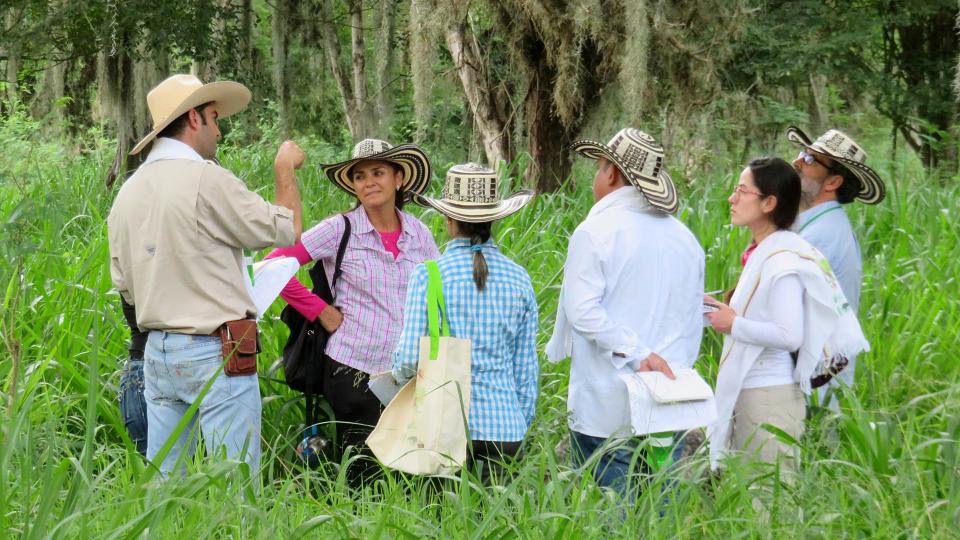
Eva Garen

The agroecological restoration system in El Dovio, Colombia managed by an ELTI alumnus.
World leaders are taking new steps to advance restoration and conservation efforts around the world, such as the global call to action by the UN Decade of Ecosystem Restoration and the recent promise by 100 nations at COP26 to end deforestation by 2030. But interventions that ignore underlying equity and justice issues fail to address root causes of degradation and decline, a new paper co-authored by Eva Garen ’95 MESc, ’05 PhD, director of Yale School of the Environment’s Environmental Leadership & Training Initiative, explains.

Eva Garen
To address this, the paper — entitled the Political Ecology Playbook and published in the journal Global Environmental Change and co-authored by YSE PhD students Samara Brock and Manon Lefévre and others — outlines 10 principles for effective, equitable, and transformative landscapes.
The playbook notes that “land degradation is not simply the result of the unsustainable activities of small landholders, population growth, or technological inadequacies but emerges from a complex set of nested biophysical, social, economic, and political processes at dynamic and interconnected local, national, and global scales.” The 10 principles put an emphasis on local knowledge and authority, prioritizing ecological and social benefits over financial rewards and collaboration across borders.
Garen, who has been director of ELTI since 2012, says that while many restoration efforts have been well-meaning, some of have led to a worsening of conditions on the ground. Below she discusses some of the challenges to efforts aimed at restoration and ending deforestation.
What are the main drivers of restoration efforts that don’t succeed?
There’s a lot of global strategies now focused on doing massive, large-scale restoration that try to find technical fixes and silver bullets, like let’s just plant trees. But it’s a red flag. You should ask, who’s going to implement and manage the restoration? Who lives on the land? Who manages and has rights to the land? These landscapes are influenced by complex histories, culture, and power dynamics — and that context is often overlooked. And when they are overlooked, you have these ill-conceived technical fixes that can end up causing a whole lot of unintended consequences. These projects usually don’t work because they don’t account for the complexities of the region.
Which restoration practices and principles are the easiest to put into action?
I don’t think much of these are easy to achieve, but I think we have to try. I focus a lot on the local arena and trying to understand local systems of natural resources and management and all the power dynamics, relationships, and nuances of those systems. And then, based on that, I try to build interventions that come from traditional systems that support sustainability and then scale things from the bottom up. There are no win-win interventions. They are always tradeoffs. But you can develop interventions at different scales that will help increase sustainability.
What are the largest barriers to protecting forests and ecosystems?
The goal is to try to make the conservation of standing forests more profitable than cutting them down, but there are so many incentives for massive destruction. There are huge political and economic systems that don’t incentivize sustainability. And I think people run when they see cultural anthropologists because they think, ‘We don’t have time to deal with what you’re telling us. We don’t have time to study a community for a decade and learn about its rich cultural history and the power dynamics driving land use decision making.’ But if you don’t use this kind of approach, it’s often not going to work.
What progress has been made?
I think people are really starting to understand the importance of addressing the root causes of degradation and deforestation. They are really trying to understand the importance of Indigenous and traditional knowledge and traditions, the value of their knowledge and building interventions with a more equitable power dynamic.
What brings you hope about achieving the goals of the playbook and ecological restoration?
The innovation and passion of the people on the ground. They are so incredibly smart and are innovating and trying all these different things. They come up with these amazing systems that build sustainability and resiliency. They teach us all the time. That’s been the highlight of my career.
For example, we have a wonderful program with our partners in Colombia where they are practicing sustainable cattle ranching built upon the integration of trees and forests. They are getting a much higher yield of meat and dairy production. And there are much higher levels of biodiversity, carbon sequestration, and carbon storage on these farms. Who would have thought that cattle ranchers would become conservationists who would help to restore some of the most critical biodiversity hotspots around the world? That was unthinkable and now it’s happening. They’re doing it because it supports their cultural practices, and it supports their livelihoods.

Colombian landholders learn about silvopastoral systems during an ELTI field course in 2019 in the El Hatico nature reserve, Cali, Colombia.